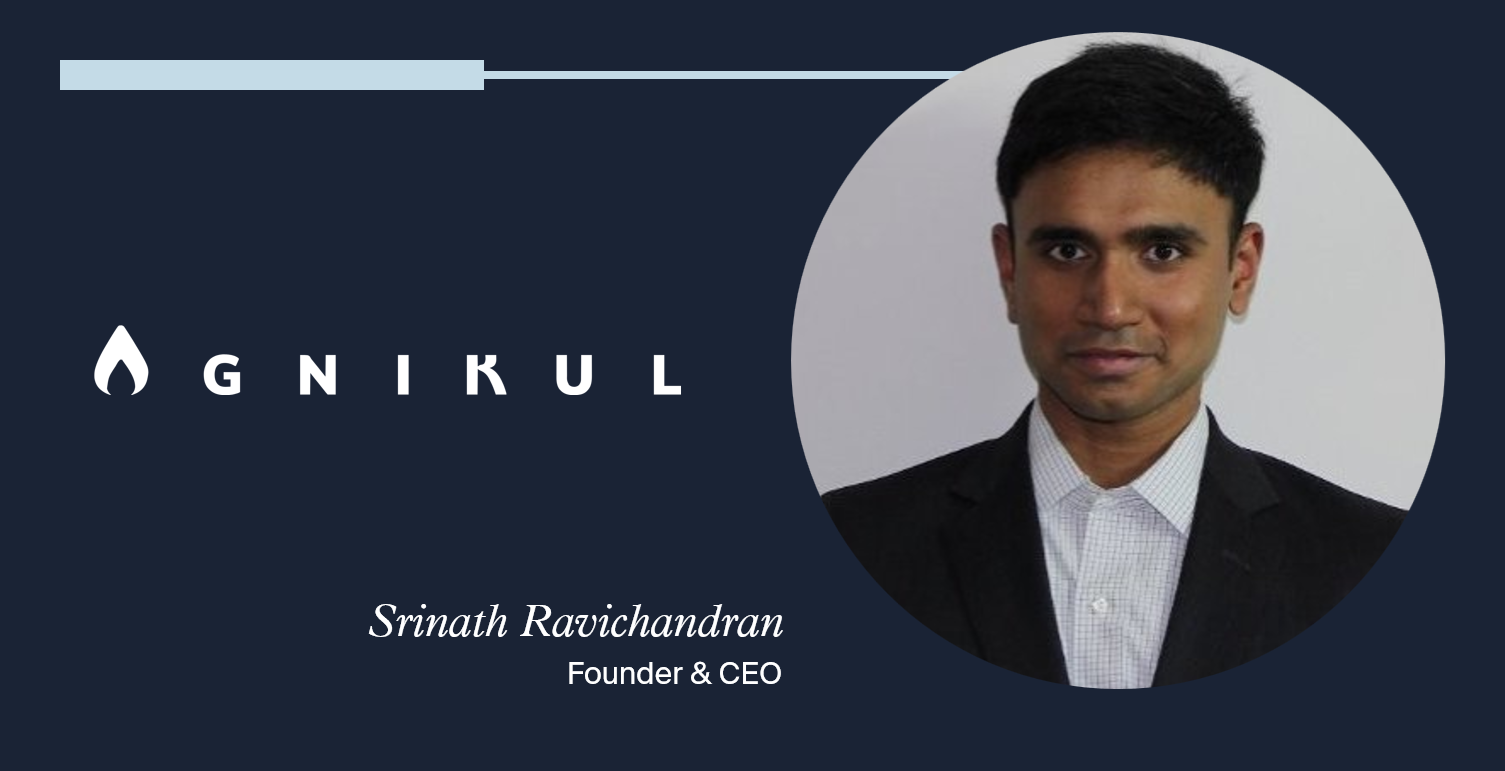Democratizing and Modernizing Space Access: A Conversation with Agnikul Cosmos
Democratizing and Modernizing Space Access: A Conversation with Agnikul Cosmos
For decades, space launch systems have remained rigid—large rockets, fixed schedules, and limited flexibility. But India’s Agnikul Cosmos, founded by Srinath Ravichandran and Moin SPM, is changing that paradigm. The Chennai-based startup is pioneering customizable, portable, small-scale rockets designed to offer on-demand access to space, what Ravichandran describes as “point-to-point transportation from any point on Earth to any point in space.”
Agnikul’s flagship vehicle, Agnibaan, is fully 3D-printed, including its rocket engines, and built with modularity, mobility, and affordability in mind. It represents a new frontier for private space companies in India and globally: flexible launch services designed for the era of small satellites and commercial space applications.
In this chat, Ravichandran discusses the origins of Agnikul, the engineering innovations behind small rockets, how they smartly shaped their designs around regulatory and safety considerations, and why the company’s long-term vision extends far beyond launch services.

For decades, space launch systems have remained rigid—large rockets, fixed schedules, and limited flexibility. But India’s Agnikul Cosmos, founded by Srinath Ravichandran and Moin SPM, is changing that paradigm. The Chennai-based startup is pioneering customizable, portable, small-scale rockets designed to offer on-demand access to space, what Ravichandran describes as “point-to-point transportation from any point on Earth to any point in space.”
Agnikul’s flagship vehicle, Agnibaan, is fully 3D-printed, including its rocket engines, and built with modularity, mobility, and affordability in mind. It represents a new frontier for private space companies in India and globally: flexible launch services designed for the era of small satellites and commercial space applications.
In this chat, Ravichandran discusses the origins of Agnikul, the engineering innovations behind small rockets, how they smartly shaped their designs around regulatory and safety considerations, and why the company’s long-term vision extends far beyond launch services.
What is the real problem you’re solving at Agnikul?
Today, satellite launches are constrained by fixed rockets and fixed schedules, essentially shared rides to space. We want to change that by enabling flexible, affordable, and rapid access to orbit.
Our goal is to make launch services as dynamic as air travel, point-to-point from anywhere on Earth to any orbit in space. Agnikul is about removing friction and creating true on demand space transportation.
Why focus on small rockets? What makes that approach compelling?
If you look at traditional launch systems, like SpaceX’s Falcon 9 or India’s PSLV, they’re designed to carry heavy payloads. They operate from fixed sites and require large payload “minimum order quantities” to be economically viable.
But satellite technology has changed dramatically. Satellites are now smaller, lighter, and more numerous, often operating in lower orbits. The market needs rockets that match this new scale.
The challenge is that when you shrink a rocket, traditional economics break down—you lose economies of scale. To make small rockets viable, we had to rethink 50 years of rocketry from first principles: materials, manufacturing, propulsion, and infrastructure. That’s what led us to 3D printing and mobile launch systems—technologies that allow flexibility and cost efficiency at a smaller scale.
You mentioned mobility and 3D printing as core technologies. Can you explain what that means for Agnikul?
3D printing, specifically metal additive manufacturing, is central to everything we do. Our rocket engine is printed as a single piece, with no welding or assembly. What comes out of the printer is a fully functional engine, reducing risk and improving repeatability.
Recently, we launched our Large Format Additive Manufacturing (LFAM) unit within our Chennai factory. It enables us to print engines and other subsystems up to a meter tall. We’ve also developed custom machines for processes like de-powdering, ensuring the entire 3D-printing pipeline stays in-house.
This not only improves quality control but also accelerates R&D cycles. We can go from design to test-ready hardware in days, not months.
How do you ensure these rockets meet safety and regulatory requirements?
We purposefully designed our system with safety, logistics, and environmental impact as first-order principles to help accelerate our progress and streamline compliance.
On the propulsion side, we use a semi-cryogenic propellant combination, aviation turbine fuel (similar to jet fuel) and liquid oxygen. It’s non-toxic, environmentally benign, and only becomes reactive once filled on the pad, making transportation safer.
We also replaced explosive separation systems, typically used between rocket stages, with pneumatic mechanisms, removing another major safety risk. And we deliberately kept our payload capacity below 500 kilograms to remain outside stricter missile-control regimes, simplifying international compliance.
Even details like turning radius and vehicle height during transport were designed to comply with highway norms, because our rockets and launch pads are mobile. These details matter when you’re building toward high launch frequency, our goal is 100 launches a year.
What does the global competitive landscape look like for small launchers?
It’s evolved a lot since we started thinking about Agnikul around 2015. Back then, there were only a few players—SpaceX on the heavy side and Rocket Lab experimenting with small payloads. By 2019, over 150 small rocket companies had formed globally, but today fewer than ten remain active.
We estimate the market can support seven to eight small launch companies worldwide, each doing roughly one launch a week. That’s about 500 launches annually—enough to serve the distributed demand for different orbits and inclinations.
Our differentiation lies in treating launch as a transportation problem—with three key variables: wait time (how long until launch), cost (price per kilogram to orbit), and location flexibility (where the launch happens and where it delivers in space).
No one else is solving for all three simultaneously. Others might offer speed or reliability, but often at higher cost or from fixed sites. We aim to combine all three.
Our goal is to make launch services as dynamic as air travel, point-to-point from anywhere on Earth to any orbit in space.
What kind of customers are driving demand for Agnikul’s services?
Primarily commercial satellite operators, especially in communications and Earth imaging. We see a lot of activity in broadband networks like Starlink and its regional variants, as well as new entrants using small satellites for IoT, weather monitoring, or defense applications.
What’s emerging now is in-space manufacturing, companies going to orbit to take advantage of unique conditions like microgravity and vacuum. For example, pharmaceutical companies synthesizing proteins, or materials firms testing polymers for tires in orbit. These applications were once limited to the ISS but are now commercializing.
Government partnerships are also key, especially in India. The Indian government is increasingly using space data for agriculture, coastline monitoring, and urban planning. With the new space policy encouraging private participation, agencies are now seeing space as a tool for development, not just a scientific pursuit.
What are some of the recent milestones for Agnikul?
A few highlights stand out. When Agnikul’s Agnibaan SOrTeD vehicle finally lifted off successfully after four aborted attempts, it marked a watershed moment in India’s private space sector. We received direct recognition from Prime Minister Modi, who marked it as “a remarkable feat which will make the entire nation proud.”
More recently we inaugurated our large-scale additive manufacturing unit, which represents a major leap in our in-house capability.
At the International Astronautical Congress, we announced plans to attempt propulsive recovery of our booster—a reusable system that would be a first for India. We also continue to refine Agnibaan, our orbital-class small launch vehicle, through iterative test campaigns.
Every milestone we hit is about shortening the feedback loop between design, print, test, and iterate—that’s how deep tech progresses.
What do you look for in investors and partners, given the deep tech nature of this industry?
Space tech is not a “quick turn” business. It has long gestation cycles, complex supply chains, and deep government interfaces. So we look for investors who understand both technology and patience, those who aren’t just chasing the next buzzword.
We need partners who can help with strategic networks, supply chains, and introductions, especially those with global LPs and industrial experience.
India’s deep tech ecosystem is still maturing, but investor appetite is growing. We’ve been fortunate to have a mix of domestic and international capital, and that blend has helped us stay globally competitive while rooted in India’s ecosystem.
On a personal note – do you have ambitions to go to space someday?
Would I go to space someday? Absolutely. To look back at Earth from low orbit—that’s been a dream since childhood.
I grew up in Chennai, fascinated by space, but took a winding path to get here starting in electrical engineering, then finance on Wall Street, and later earning a master’s in aerospace engineering at the University of Illinois.
Eventually, I moved back to India to start Agnikul and build rockets from scratch. It took me nearly 30 years to find my way into space tech, but it’s been worth it.




.jpeg)

